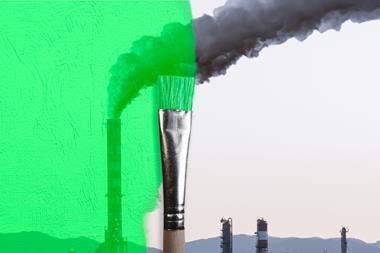Cutting carbon has fallen down the agenda for some due to claims inflation, says technical and complex loss director for environmental
Specialist loss adjustor QuestGates has this month (13 October 2022) launched its new Carbon Calculator portal as part of a drive towards net zero.

The new tool has been designed to measure the carbon cost of remediation and reinstatement works in a bid to help QuestGates and its supplier network promote sustainable remediation techniques.
It also aims to eradicate waste sent to landfill and encourage the use of energy efficient plant machinery and equipment.
The tool was developed in conjunction with the firm’s panel of environmental consultants and specialist carbon consultancy Blue Marble.
So far, the loss adjustor has tested the Carbon Calculator on several environmental claims.
It now plans to extend the technology to its entire environmental division and then to its surveying team, with the intention of adding a carbon footprint figure to all of QuestGates’ first party claims by the end of 2023.
One major composite insurer and two specialist insurers are currently on board with the new calculator.
Greg Laker, director for operations at QuestGates, said that implementing the portal would “enable [QuestGates] to facilitate a remedial options appraisal that not only factors in efficacy, financial cost and timescale, but also how environmentally sustainable each option would be in terms of measured carbon footprint”.
Laker further noted that the tool aims to help the loss adjustor’s insurer partners measure Scope 3 emissions.
Channelling science
According to the National Grid, Scope 3 emissions include those that are not produced by the business itself or as a result of activities from assets owned or controlled by them. Instead, it refers to emissions that the business is indirectly responsible for in its value chain.
Scope 3 emissions are a key component of QuestGates’ implementation because “a lot of people use estimated figures” instead of obtaining a true measure based on data, said Laker.
Richard Lawrence, QuestGates’ technical and complex loss director for environmental who was responsible for birthing the idea for the calculator nearly two years ago, explained: “I was looking at a remediation proposal from one of our environmental contractors and it set out four options for remediating with the site – [these] included what the cost of each option would be, what the timescales would be, how disruptive it would be for the site or the customer, but also how sustainable each option would be.
“[However] the document I was looking at on the sustainability column [only] had three categories – low, medium or high – and it didn’t have any sort of quantification or detail as to how they arrived at that classification.”
Lawrence therefore highlighted that if the loss adjustor is responsible for telling its clients how sustainable or otherwise a remedial option would be, “there needs to be science behind it”.
To create the calculator, QuestGates’ partners have gathered data published by the UK government – combined with industry and carbon consultancy research.
Contractors using the calculator can enter line by line information about how many people are on site and how they are travelling to the location, for example.
“That basically produces quite impressive data in terms of what the CO2e (carbon dioxide equivalent) cost would be for that project, but also broken down between things like materials, fuel, plant, machinery [and] labour,” Lawrence added.
“The intention is that it will drive the philosophy and the methods towards a more sustainable remediation project as opposed to something that’s more costly in terms of carbon.”
Claims inflation impact
In terms of challenges the firm will face when implementing the calculator, Laker said that while sustainability is generally top of the agenda for insurance companies’ supply chain management, claims staff were still in the process of being won over.
Read: FCA proposes new rules to intercept greenwashing
Read: Reinsurers risk misunderstanding secondary perils due to less mature modelling
Explore more news content here
“Sometimes the most carbon efficient reinstatement could be the cheapest [option], but at the same time it could be more expensive,” said Laker.
“When you have a cost of living crisis where we’ve got claims inflation running [between] 10% [and] 11% above where it should be, I think there is a bit of a challenge for us as an industry to convince our clients that they need to start looking at cutting carbon.
“I’m not convinced it’s the number one thing on the agenda for the claims people,” he said.
Lawrence, meanwhile, said that “getting the right calculations and measurements is a challenge” as the Lifecyle Assessment (LCA) needs to be taken into consideration when dealing with carbon cost.
“It’s not like if you go to a restaurant and it tells you on the menu how many calories you’re about to consume. You don’t buy a piece of wood with that sort of information.
“Where was that tree grown? Was it in Canada? Or was it in Norway? And therefore, what’s the carbon costs of getting it into Travis Perkins, for example.
“Those sorts of variables are a big challenge in getting to a point where you can actually put a CO2e cost on a piece of material or a plant or a piece of plant machinery.”
When asked about their emotions behind the creation, Laker and Lawrence pointed to it being a “humbling” and “eye-opening” experience.
Laker said: “Perception and reality can be quite different. Now we’ve actually got a mechanism for driving a different outcome and looking at cost. What you’ll find is that the most sustainable option isn’t always the most expensive.
“[Insurance companies] are in a win-win if they can deal with the carbon emissions [and] improve the planet – then there will be fewer storms, less flooding and actually they will make more money out the back of it because they won’t have as many claims.”
Hosted by comedian and actor Tom Allen, 34 Gold, 23 Silver and 22 Bronze awards were handed out across an amazing 34 categories recognising brilliance and innovation right across the breadth of UK general insurance.



















































No comments yet